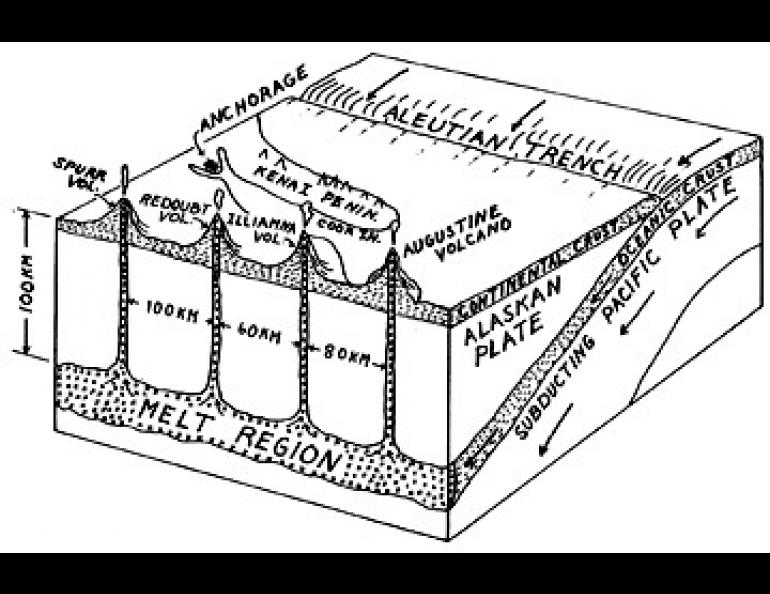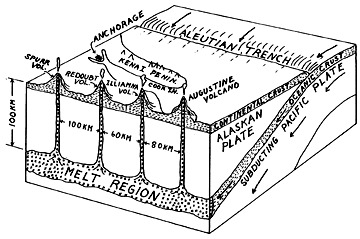
Volcano Spacing
Men tend to plant trees evenly spaced in rows, but Nature uses a seemingly more random pattern. Therefore, most fixed objects we see in nature are irregularly distributed, and when a regular pattern emerges, it tends to catch our eye.
One such pattern--and a mysterious one--is the rather even spacing of volcanoes on the Alaska Peninsula and elsewhere out along the Aleutians. The Aleutian Islands themselves are just the upper parts of volcanoes perched on the sea floor.
On the west side of Cook Inlet, Spurr, Redoubt, Iliamna and Augustine stand like a row of well-drilled soldiers spaced roughly 70 km (42 miles) apart. Down the Alaska Peninsula to the southwest, the volcanoes are closer ranked but still relatively evenly spaced about 50 km (30 miles) apart.
A possible cause of this remarkable evenness of spacing has been offered by geoscientist Bruce D. Marsh of Johns Hopkins University in an article appearing in the March-April issue of American Scientist. The idea is easiest to describe, and perhaps to understand, by resorting to examples. One of the best is the behavior of paint if too thick a brushful is applied to a vertical wall. The paint runs down the wall, not evenly, but in fingers spaced some distance apart. The spacing depends upon the thickness of the paint, how viscous it is and perhaps also upon the roughness of the wall to which the paint is applied.
If one liquid is moved through another having different characteristics, this same development of fingering occurs. The same is true of two gases moving against each other, as seen in the pattern of smoke curling up from a cigarette.
This curious tendency for moving liquids and gases to develop filamentary structure is known as the Rayleigh-Taylor instability. It can be described by mathematical formulas which clearly indicate that the fundamental underlying cause is the difference in viscosity of the materials involved. Viscosity tells how well a material clings to itself. The greater the difference in viscosity between two gases or liquids thrust together, the greater is the spacing between the filaments that appear. And even rocks, which we normally consider to be solids, can flow like liquids over a long period of time.
Consequently, volcanoes can be caused by liquid magma floating up through thick layers of highly viscous quasi-liquid-like rocks. The source region quite clearly is an elongated liquid body at about 100 km (60 miles) depth created by the melting of subducted rock. Thought of this way, it seems quite natural that the volcanic magmas would undergo the Rayleigh-Taylor instability and so create an evenly spaced row of volcanoes.





